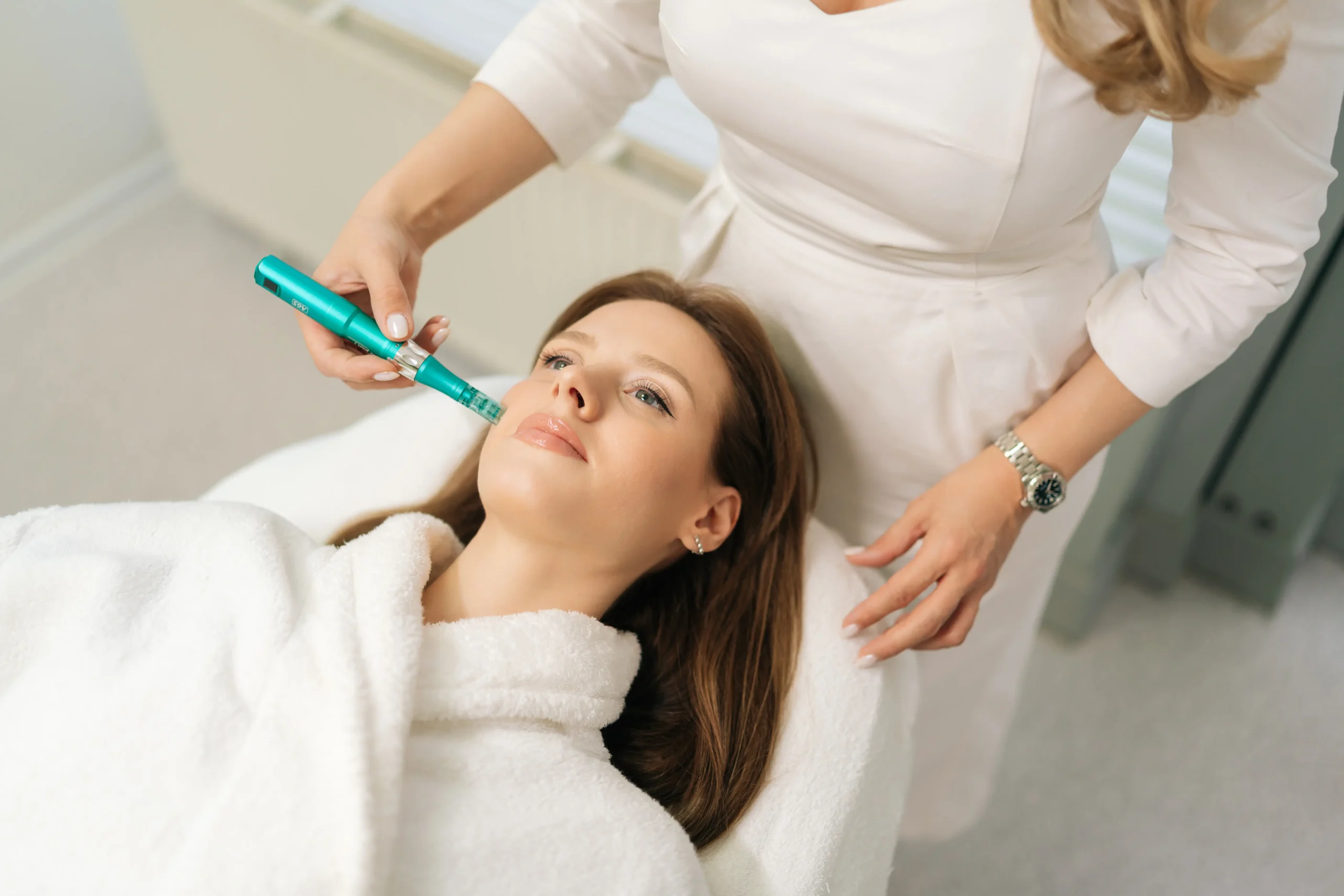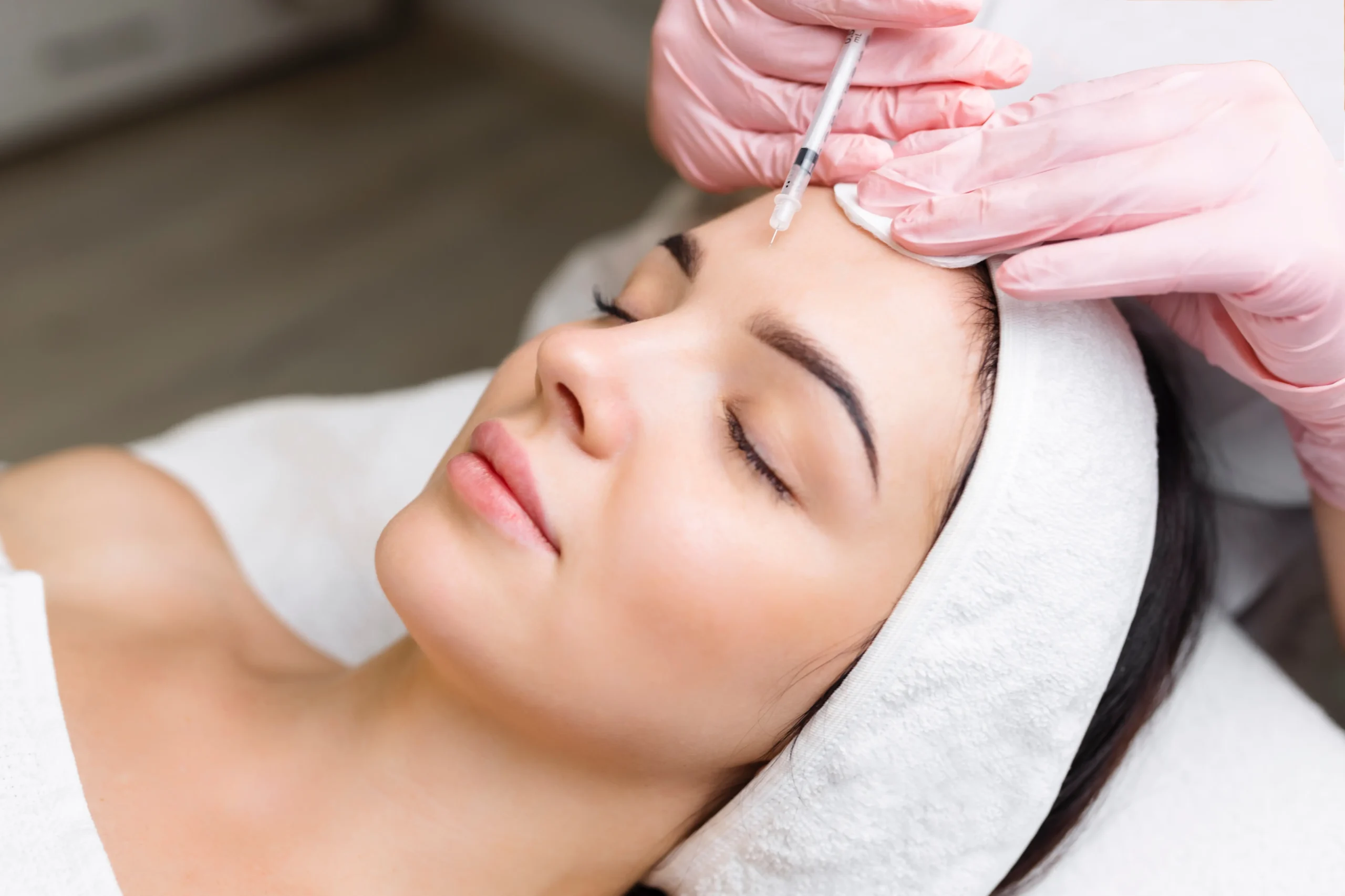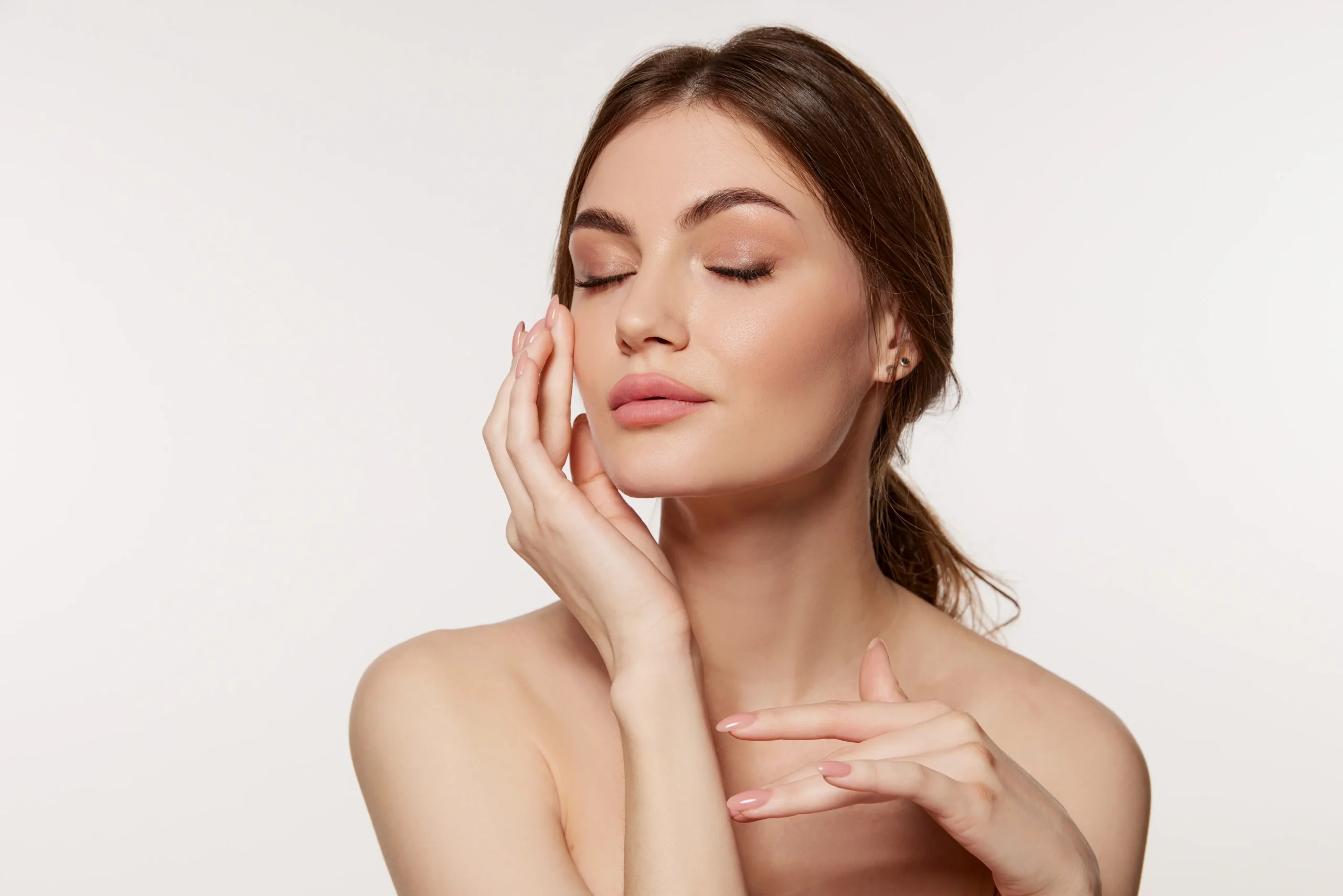A chemical peel is a powerful skin rejuvenation treatment that can significantly boost your confidence. I’ve seen firsthand the transformative effects of this procedure. While the name might sound intimidating, a chemical peel is a sophisticated, controlled process designed to work with your skin’s natural renewal cycle. This treatment is highly effective for addressing concerns like sun spots and a tired, dull complexion, helping you achieve brighter, more vibrant skin.
Key Takeaways:
- A chemical peel is a professional cosmetic treatment that uses a specialized solution to deeply exfoliate the skin, encouraging dead, damaged cells to shed and reveal healthier skin underneath.
- Top Benefits: It dramatically improves skin tone and texture, diminishes fine lines, fades dark spots and sun damage, helps manage acne, and even makes your at-home skincare products work better.
- Types: Peels are not one-size-fits-all. They range from light “lunchtime” peels to more intensive deep peels, each customized to your specific skin goals.
- Safety is Paramount: A successful peel depends on the skill of your provider. Always seek treatment from a qualified, licensed professional. In fact, its popularity is a testament to its efficacy; according to the American Society of Plastic Surgeons’ 2023 report, nearly one million chemical peels were performed in the U.S. last year alone.
What Exactly is a Chemical Peel?
Let’s demystify the name. A chemical peel is simply a form of accelerated exfoliation. Think of your skin as having multiple layers. The outermost layer, the stratum corneum, is mostly composed of dead skin cells bound together. Sun damage, age, and environmental factors can cause this layer to become thick, dull, and uneven.
During a peel, we apply a carefully selected chemical solution (often derived from natural sources like sugar cane or milk) to the skin. This solution works by gently dissolving the “glue” that holds those old, tired cells together. Over the next few days, these cells shed, revealing a fresh, smooth, and undamaged layer of new skin.
But the magic doesn’t stop at the surface.
Note from Rosalie: People often think a peel is just about removing skin, but its real power is in what it inspires the skin to create. By initiating this controlled shedding, we’re sending a signal to the deeper layers of the skin to kickstart their natural repair cycle. This process stimulates the production of new collagen the protein that gives skin its youthful firmness and elasticity. So, you’re not just getting a surface-level treatment; you’re investing in the long-term health and structure of your skin.
The Top 7 Benefits of Getting a Professional Chemical Peel
When performed correctly by a trained professional, a chemical peel can address a remarkable number of skin concerns at once. Here are the top benefits I see in my clients every day at our Sarasota practice.
1. Fades Discoloration and Hyperpigmentation
This is one of the most common reasons clients seek out peels. Whether it’s the stubborn brown spots from sun damage (solar lentigines), the dark marks left behind by acne (post-inflammatory hyperpigmentation), or the frustrating patches of melasma, a peel can make a world of difference. The chemical solution lifts away the excess pigment stored in the superficial cells, leading to a much more even and uniform skin tone.
- Data You Can Trust: A 2021 study in the Journal of Clinical and Aesthetic Dermatology confirmed this, showing that a series of targeted peels resulted in significant improvement for patients with moderate-to-severe melasma.
2. Reduces Acne and Unclogs Pores
For my clients struggling with acne, peels can be a game-changer. Peels containing Beta-Hydroxy Acids (BHAs) like salicylic acid are oil-soluble. This means they can dive deep into the pores to break up the mixture of oil, dead skin cells, and debris that causes blackheads and inflammatory pimples. It not only helps clear existing breakouts but also keeps pores clean to prevent new ones from forming.
- My Experience: I have a young client who had been battling persistent acne for years. After a customized series of salicylic acid peels, she came in for a follow-up, and the change was incredible. It wasn’t just that her acne was gone; it was the look of relief and confidence on her face. She finally felt in control of her skin.
3. Smooths Fine Lines and Wrinkles
While peels can’t erase deep-set wrinkles, they are fantastic for softening the appearance of fine lines, especially those around the eyes and mouth. A light peel instantly improves them by removing the top layer of skin, but a medium-depth peel goes further. By stimulating that all-important collagen production I mentioned earlier, it helps to plump and firm the skin from within for a naturally smoother look.
4. Improves Overall Skin Texture and Radiance
Do you ever feel like your skin just looks… dull? That’s often due to a buildup of dead skin cells that diffuse light, robbing your skin of its natural glow. A chemical peel effectively hits the reset button. By removing that rough, uneven outer layer, we reveal the newer, healthier cells beneath. The result is a smoother texture that feels baby-soft to the touch and reflects light beautifully, giving you that coveted radiant glow.
5. Minimizes the Appearance of Scars
For those with shallow, rolling, or atrophic acne scars, a series of medium-depth peels can be incredibly effective. Each peel works to gently resurface the skin, and the subsequent collagen remodeling helps to raise the “floor” of the scar, making its edges softer and the overall depression less noticeable. While it’s not a solution for very deep, “ice-pick” scars, the improvement in overall texture can be profound.
6. Enhances Skincare Product Absorption
Are you investing in high-quality serums and moisturizers? A chemical peel helps you get the most out of them. That thick layer of dead skin cells can act like a barrier, preventing your expensive products from penetrating properly. After a peel, with that barrier removed, your skincare products can absorb far more effectively into the skin, making them work better and delivering more visible results. It’s a win-win.
7. It’s a Completely Customizable Treatment
This is a point I always stress to my clients. “Chemical peel” isn’t a single treatment; it’s a category of treatments. As your provider, I can customize everything—the type of acid, its strength, and how long it stays on your skin—to perfectly match your skin type, your concerns, and your lifestyle. Whether you need a gentle refresh or a more significant renewal, there is a peel protocol we can design specifically for you.

Light, Medium, or Deep: Which Peel is Right for You?
Understanding the different levels of peels is key to managing expectations for both results and downtime.
- Superficial (“Lunchtime”) Peels: These are the gentlest peels, using mild acids like Glycolic, Lactic, or Salicylic Acid. They work on the very top layer of skin to address issues like minor dullness, rough texture, or mild acne. The “lunchtime” nickname comes from the minimal downtime—usually just a bit of redness for a few hours and maybe some light flaking for a day or two. They are often done in a series for the best results.
- Medium-Depth Peels: These peels, often using Trichloroacetic Acid (TCA) or stronger Glycolic Acid formulations, penetrate more deeply. They are my go-to for treating moderate sun damage, more noticeable fine lines, persistent pigment issues, and shallow acne scars. The results are more dramatic, but so is the downtime. You can expect about 5-7 days of redness, swelling, and significant skin peeling.
- Deep Peels: Using a strong acid like Phenol, these are the most aggressive type of peel. They are reserved for treating deep wrinkles, severe sun damage, and sometimes even pre-cancerous growths. Because of their intensity, they are performed only by a physician, often require sedation, and involve a lengthy recovery period. They are performed much less frequently today but are a powerful tool in the right hands.
From Consultation to Recovery: The Chemical Peel Process
Knowing what to expect can make the process feel much more comfortable. Here’s how we walk our clients through it at Rose Medical Aesthetics.
- The Consultation: This is the most important step. We sit down and have a real conversation about your skin history, your lifestyle, and your goals. I need to know about your medical history, any medications you’re on (like Accutane), and if you’re prone to cold sores. This is where we build a plan together and ensure you are a safe candidate.
- Pre-Peel Skin Prep: For some peels, especially medium-depth ones, I’ll have you prep your skin for a few weeks beforehand. This often involves using a retinoid (like tretinoin) to enhance peel penetration and a tyrosinase inhibitor to prevent post-treatment hyperpigmentation. This “primes” the skin for a better, more even result.
- The Procedure Itself: On the day of your peel, we’ll start by thoroughly cleansing your skin to remove any oils. Then, I’ll apply the peel solution. You’ll feel a warm, tingling, or stinging sensation—this is normal! We monitor your skin closely the entire time. After a set period, we neutralize the peel and apply a calming, soothing balm and, of course, sunscreen.
- Aftercare and the Peeling Process: We send you home with very specific instructions. The rules are simple: be gentle, stay hydrated, and protect your skin from the sun. This means using a gentle cleanser, applying a rich moisturizer or ointment frequently, and being absolutely diligent with a high-SPF, broad-spectrum sunscreen. You will see flaking or peeling, and it is crucial that you do not pick or pull at it! Let your skin shed on its own schedule.
Frequently Asked Questions (FAQ)
- How much does a chemical peel cost? The cost varies widely depending on the type of peel, your geographic location, and the expertise of the provider. Light peels can start around $150-$300, while medium peels can range from $500 to over $1,000.
- Does a chemical peel hurt? Most patients describe the sensation as a temporary stinging, tingling, or feeling of heat while the solution is on the skin. We use fans and other cooling techniques to ensure you’re comfortable. Any discomfort subsides as soon as the peel is neutralized.
- Who is NOT a good candidate for a chemical peel? Peels are not recommended for those who are pregnant or nursing, have active skin infections or diseases, have cut or broken skin, or have taken isotretinoin (Accutane) in the last six months. It’s also critical to assess Fitzpatrick skin type, as darker skin tones have a higher risk of pigmentation issues if the wrong peel is used.
- What’s the difference between a professional peel and an at-home one? The difference is safety and strength. Professional peels use higher concentrations of acids that require expert application and neutralization to be safe and effective. At-home peels are far less concentrated. I strongly caution against buying professional-grade acids online—I have seen patients in my clinic with burns and permanent scars from DIY attempts. This is a procedure that absolutely requires a professional’s hand.
Is a Chemical Peel Worth It? Your Path to Radiant Skin
A chemical peel is so much more than a simple skin treatment. It’s a true partnership between you and your provider a process designed to reset your skin and reveal the healthy, radiant complexion that lies beneath. From fading stubborn sun damage to smoothing texture and clearing acne, its benefits are a powerful way to restore both the health of your skin and your confidence.
Here at Rose Medical Aesthetics in Sarasota, we don’t just perform procedures; we guide our clients on a journey to their best-ever skin. Seeing that “after” glow and the renewed confidence it brings is the most rewarding part of what I do. If you’re ready to explore how a chemical peel can be tailored to your unique beauty, the first step is simply a conversation.




